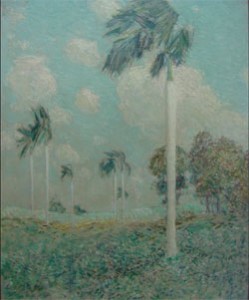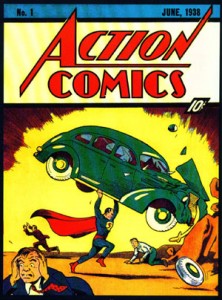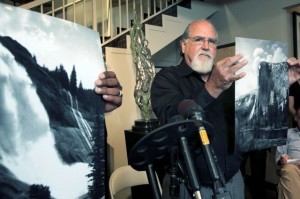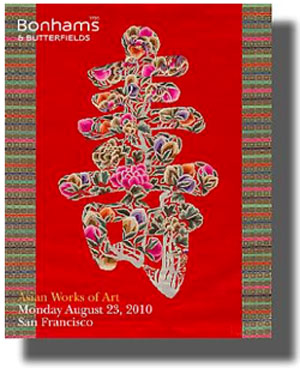Articles by admin
John W. Coker announces Sept. 15 no-reserve auction of Dr. Albert K. Chapman collection of Impressionist, Post-Impressionist treasures
Monday, August 9th, 2010‘Intensely private’ former chairman of Eastman Kodak formed core of collection
from 1930s-1960s; very few knew of its existence
NEW MARKET, Tenn. – An extraordinary and virtually unknown collection of Impressionist and Post-Impressionist masterworks amassed by the former president and later chairman of the board of Eastman Kodak will be auctioned without reserve on Sept. 15, 2010, at the John W. Coker gallery in New Market, Tennessee.
The Dr. Albert K. Chapman (1890-1984) collection, which has been privately held in three subsequent generations of the Chapman family since the 1930s, includes artworks by Childe Hassam, Alfred Sisley, Pierre Bonnard and 30 other distinguished artists from the period 1870 to 1950. None of these paintings were exhibited at any time while in the hands of either Dr. Chapman or his heirs. Additionally, the collection is graced by a superb pastel work by Mary Cassatt that has been exhibited only once since joining the Chapman collection – at the Smithsonian Institution in 1970.
The collection’s 65 artworks, many accompanied by bills of sale or other written provenance, are described by auctioneer John Coker as “lost and forgotten treasures that are sure to excite the fine art community.”

Mary Cassatt, Simone Talking to Her Mother, pastel on paper, 25½ by 30½ inches, est. $200,000-$400,000. John W. Coker Auctions image.
“Very few people even knew Dr. Chapman’s collection existed,” Coker said. “Most of his acquisitions were made prior to the 1960s, and once he purchased a painting, he did not want it out of his possession. They are untouched, with no visible signs or cleaning or repairs, and with the exception of the Cassatt, the paintings were never exhibited or displayed outside the family home after he acquired them.”
According to Dr. Chapman’s grandson and granddaughter, who are the collection’s consignors, not even the few close friends their grandparents, and later their parents, chose to entertain in their homes had any idea the artworks were originals. “This is a family of intensely private, highly refined people who would not have made a point of mentioning the art was original, as this might have been misconstrued as an ostentatious show of wealth,” Coker said.
Dr. Chapman’s greatest prize was Childe Hassam’s (American, 1859-1935) oil on canvas titled Royal Palms, Cuba, which will be included in an upcoming catalogue raisonne. Its bill of sale indicates that the 25- by 30-inch artwork depicting towering palm trees against a cloud-filled turquoise sky was purchased from the M. Knoedler & Co. gallery in 1948 for $1,500. The 1895 painting was previously owned by Horatio S. Rubens, a Cuban-American tobacco industry lawyer who boasted that he had bankrolled the sinking of the

Childe Hassam, Royal Palms, Cuba, oil on canvas, 1895, 25 by 31 inches, est. $300,000-$600,000. John W. Coker Auctions image.
U.S.S. Battleship Maine during the Spanish-American War. “We believe Rubens was quite likely the original owner,” Coker said.
A succession of European ambassadors and dignitaries had previously owned Mary Cassatt’s (American, 1844-1926) Simone Talking to Her Mother, a 25- by 30-inch pastel on paper that was another of Dr. Chapman’s purchases from the Knoedler gallery. He acquired it in 1950 for around $5,000. Making a rare exception, Dr. Chapman loaned the artwork to the Smithsonian in 1970 for Adelyn Dohme Breeskin’s exhibit and accompanying catalogue raisonne. Ten years later, Dr. Chapman received a letter from a man hoping to buy the painting from him. Paperwork discovered in the Chapman archive documents the doctor’s sincere reply: “Thank you for your enquiry of December 5, but I have no intention of selling the Mary Cassatt. Living with it gives us entirely too much pleasure to have it depart.”
Dr. Chapman was a “brilliant inventor” who held a patent for a type of prismatic effect used in photography, Coker said. “When you look at his art selections as a whole, you’ll see the same array of colors as in a prism.” An example would be Pierre Bonnard’s (French, 1867-1947) Landscape St.-Tropez, a 1956 acquisition that depicts a lush view of mountains across a bay, with a bridge leading to a beachside village.

Gustave Loiseau, Roof Top View from Artist’s Studio, oil on canvas, 25 by 21 inches, est. $40,000-$60,000. John W. Coker Auctions image.
Other alluring works include Gustave Loiseau’s (French, 1865-1935) Roof Top View from Artist’s Studio and Emile Bernard’s (French, 1868-1941) Pont Aven, purchased in 1961 from the M.R. Schweitzer Gallery on Madison Avenue in New York. The hilly village landscape with grazing fowl is accompanied by a two-page letter [written in 1961 in French, with translation to English] from the artist’s son, in which he confirms that his father painted the unsigned picture in 1889 in Brittany.
Paysage Ain, a 1917 painting by Suzanne Valadon (French, 1865-1838) – mother of Maurice Utrillo – was purchased in 1953 for $5,750 from Sam Salz Inc. of Park Avenue, New York. The verdant, long-range view from a hillside perspective was previously in the collection of Edouard Herriot (1872-1957), three-time Prime Minister of France. The picture was exhibited twice in Paris – in 1924 and 1931. The Chapman archive included a letter from Sam Salz in which the art dealer wrote: “I have known of this painting for a long time, and it was always my intention to buy it for myself.”
Coker said he made it his mission to locate all existing written provenance held in Dr. Chapman’s records so the documents could be permanently reunited with the artworks. “Luckily, Dr. Chapman kept his receipts, and eventually I was able to find all of the backups by digging through his files,” said Coker.

A.T. Hibbard, Late Sun, oil on canvas, 36 by 28 inches, est. $15,000-$25,000. John W. Coker Auctions image.
Dr. Chapman also appreciated the work of a variety of regional artists.” The collection includes Anthony Thieme’s (American, Rockport school, 1888-1934) Entrance to Magnolia Gardens in Spring, Charleston, S.C.; A.T. Hibbard’s (American, Rockport school, 1886-1972) Late Sun; and Harry Leslie Hoffman’s (American, 1871-1964) oil on board titled The Cotton Pickery – Savannah.
Additional highlights of the collection include Camille Pissaro’s (French, 1830-1903) graphite-on-paper work titled Young Lady Reading in Bed and Alfred Sisley’s (English, 1839-1899) Conte crayon-on-paper sketch for the painting La Rade de Cardiff.
“This magnificent collection most certainly would have been welcomed by any of the major auction houses in New York, London or Paris, so it is a tremendous honor for us to have been chosen to sell the artworks for Dr. Chapman’s heirs,” Coker said.
The no-reserve auction of the Dr. Albert K. Chapman Fine Art Collection will be held on Sept. 15, 2010 commencing at 10 a.m. Eastern Time. All forms of bidding will be available, including live in the gallery, absentee, phone and live via the Internet through LiveAuctioneers.com. Complete auction and bidding details appear on John Coker’s Web site at www.antiquesonline.com. The fully illustrated auction catalog may be viewed online at www.liveauctioneers.com, www.antiquesonline.com or www.auctionzip.com beginning Aug. 10.
John W. Coker’s auction gallery is located at 1511 W. Hwy. 11E, New Market, TN 37820. For additional information, call 1-865-475-5163 or e-mail john@antiquesonline.com. Visit the company’s Web site at www.antiquesonline.com.
Reyne Gauge: Superman Saves the Day! By Reyne Haines
Monday, August 9th, 2010 Who doesn’t like a happy ending? I know I do, and I especially love it when antiques play a role in that ending.
Who doesn’t like a happy ending? I know I do, and I especially love it when antiques play a role in that ending.
Everyone is going through hard times and is looking to save a few dollars here and there. Many of us have lost our jobs and there seems to be nothing on the horizon. Some of us have dealt with collectors, credit card fee increases, and issues obtaining loans from banks. Let’s face it; it’s not easy out there.
One struggling family recently was staring foreclosure in the face, but was fortunate to stumble across the answer to their problems; a comic book that was found in their basement.
We’ve read numerous articles lately about the record prices being achieved at auction for comic books. Six figures have been paid time and again for some of our favorite childhood memories.
The family had lived in their home since the 1950s, and were about to lose it to the bank. They were devastated. As they packed up 60 years of memories, they found a box of old comic books. Many of them were worth $10 to $30, however, there was one diamond in the lot. It was a copy of Action Comics #1, dated June 1938. The cover depicts the man of steel lifting a car above his head. The original price tag; 10 cents – value today, up to $250,000.
After unearthing the box of comics, the family decided to search online for their values. They read how ComicConnect.com had brokered two Action No 1 books – one for $1 million in February and then another for $1.5 million in March.
Comics are valued by issue, but also like many other items, by their condition. This copy was recently rated as a 5.0 VG which is a Very Good rating on a scale of 1-10 hence the lower value.
The family, who wishes to remain anonymous, is still a bit overwhelmed with their find. They realize their luck in having found the comics, just in the nick of time. It is as if Superman was called in to save the day.
Bonhams & Butterfields – SoMa Estate Auction
Monday, August 9th, 2010Bonhams & Butterfields – Asian Works of Art
Monday, August 9th, 2010Picking with Reyne – Vol 14 – By Reyne Haines
Monday, August 9th, 2010 This was an exciting week in the world of picking. CNN first reported a guy who was a garage sale enthusiast who had purchased a set of negatives some years ago for $45.00.
This was an exciting week in the world of picking. CNN first reported a guy who was a garage sale enthusiast who had purchased a set of negatives some years ago for $45.00.
Recently the buyer took a closer look at them and thought they might be something. He showed them to an unnamed appraiser, only to be told they were the works of Ansel Adams and worth $200 million dollars.
Now, I can only imagine how visions of new cars, homes and trips around the world were running through his mind. I know they would be if it was me (ok, maybe visions of Christian Louboutin’s, a vintage Corvette, and a home on the ocean…)
In the meantime, the press catches wind of the story and reaches out to Ansel Adams grandson who reviews them and does not believe they are the works of his grandfather.
The owner of the negatives plans to setup a website to sell prints of the images on the negatives for $45 for a poster and $7500 for a darkroom print. The managing director for the Ansel Adams Publishing Trust is considering suing the buyer for using a copyright name for commercial purposes.
We’ve all had finds over the years we’ve thought were something, only to find out later they were a clever fake. Whether is a reproduction piece of furniture, a lamp, or a painting…you have to be careful. Take the time to do due diligence before buying, or making a claim like this owner has. That initial $45 investment might end up costing him millions before it’s all said and done.
Tell us your stories of great finds that turned out to be great duds here!
Reyne
Collecting with Jeff – July Newsletter – By Jeff Figler
Wednesday, July 28th, 2010The following articles Jeff wrote recently for the St. Louis Post-Dispatch.
THE MASTERS TOURNAMENT
Arguably, a ticket to the Masters Tournament has the reputation of being the hardest ticket to get in all of sports. From my golfing aficionado friend Jerry Rockwell, a ticket is not as difficult as it has been, but it is still mighty tough. You can get a ticket if you are a patron, have connections, or, oh my gosh, have the money. Rockwell should know. A former touring pro on the Grapefruit Tour, now called The Nationwide Tour, he has been to virtually every Masters since 2005. He also holds the dubious distinction of trying to teach me how to play golf, but he failed miserably. I don’t know why, but golfing and me are simply incompatible. Despite that, I am a golf fan, and of the Masters in particular.
Besides tickets to the Masters being difficult to procure, and relatively pricey, memorabilia also can be a bit costly as well. Try these auction results. A 2005 Arnold Palmer-signed Masters Tournament Flag went for $353, a 1974 Masters Badge for $250, and a 1975 Spectator Guide Program for $125. In addition, a 1997 Gene Sarazen button sold for $895 in a 2008 auction, while a 1998 menu signed by Tiger Woods brought in $2932.
However, one of the most unique auction items has been the 1997 Tiger Woods Masters Tournament-used golf bag. You are probably wondering how much that went for. Well, first keep in mind that 1997 was the first year that Tiger Woods won the Masters. Okay, how about $89,625. And the bag was not even signed. I don’t know who owns it, but I know I don’t. That is not your typical item. An item that is a little less expensive is a Woods-signed Masters flag. It went for $1248. A little more like it.
I wouldn’t mind adding a ticket to the Masters to my collection. Does anyone have an extra one?
NATIONAL SPORTS COLLECTORS CONVENTION
One of the true annual highlights for many sports collectors is the National Sports Collectors Convention. This year the Convention will be held, for the first time, in Baltimore, from August 4-8, 2010.
As the Convention is on the East Coast, that may defer some collectors from coming if they are from too far away. But it is good to move the venue around.
The Convention is a great opportunity to see if any of your “wish list” items are available. It is also the perfect place to see old friends in the industry.
If you haven’t been to a National before you will see booths of large and small vendors from across the country. Do yourself a favor, and have a list of what you are specifically looking for. If you don’t, and if you don’t have a budget, trust me, you can easily be overwhelmed. A few years ago I had a “wish list” of four items, and wouldn’t you know it, I found three of them at the Convention. The other one took a couple more years to get.
At this National also there will be approximately 60-70 Hall of Famers and other stars from the major sports there to sign autographs. A few of this year’s signing stars include Cal Ripken, Jr., Willie Mays, Brooks Robinson, Tom Seaver, Bart Starr, and Joe Montana.
What started out in 1980, when a group of collectors got together in a small hotel ballroom at the Los Angeles International Airport Marriott, for what became the first National Sports Collectors Convention, has now become a full-fledged major convention.
And if you do go, try to come one of the early days in the Convention. If you wait too long, some of the vendors may be gone, as well as some of the items that you specifically wanted.
See you in Baltimore.
Bohnams & Butterfields – Fine Jewelry & Watches – Quail Lodge Carmel, California
Wednesday, July 28th, 2010Antique Jewelry: “Lover’s Eyes” Georgian Watercolor Miniatures
Wednesday, July 28th, 2010In 1784 the widow Maria Fitzherbert was introduced to The Prince of Wales– who would later become George IV– at a gathering in London. The two began a secret affair that would continue until their controversial wedding in the drawing room of her home a year and a half later. In the interim, in order to carry a keepsake of his paramour while keeping her identity hidden, the prince had a miniature watercolor created of her—but not of her entire face. Her eye—just one of them—was drawn on a tiny piece of ivory which the prince carried around like a locket. The effect was charming, whimsical and mysterious, and “lover’s eyes” soon took off as a trend among members of London high society.
Between 1790 and about 1825, it became a popular custom to have a miniature watercolor of the eye of a lover, friend, or sister painted, and then sealed under glass and ornamentally framed in a ring, brooch, or pendant. Sometimes the portrait extended as far as the eyebrow, and some portraits contained hints of sideburns or soft curls of hair. The rings and lockets were designed for men as well as women, though most pieces feature portraits of women no matter which gender wore or carried them.
Though the practice of keeping a lover’s eye was persistent, it never quite became universal. The custom continued for a quarter of a century, but less than a thousand or so of these tiny portraits exist in the world today. Because of their scarcity, lover’s eyes are now considered extremely valuable and coveted pieces of antique jewelry.
It’s difficult to adequately describe the weird beauty of an authentic Georgian lover’s eye. When set in antique rings especially, these portraits are not at all out of place in the most elegant vintage antique jewelry collections. But they also call to mind a curiously modern and playful steampunk style– half ornamentation, half secret code, and suggestive of a different form of Georgian art, the anatomical sketch. True lover’s eyes are utterly mesmerizing specimens of antique jewelry, and their high appraisal value only adds to their elusively.
Even more so than with other forms of antique jewelry, forgeries of lover’s eyes abound. With modern scanning technology, the portraits have become easy to replicate, and of course high demand only increases the temptation to counterfeiters. If you own a lover’s eye, take the proper precautions before you part with it. And if you plan to invest in one, be aware that lover’s eyes represent a foray into what is considered high–risk collecting. Even skilled antique jewelry appraisers can mistake authenticity, and the sheer beauty of a piece for its own sake can be fatally alluring.
Remember: there are very, very few of these in the world. If the cost a lover’s eye seems too good to be true, it probably is. Appreciate the artistry and the history of the piece, but be cautious.
By Erin Sweeney
Asian Antiques: Japanese Combs of the Edo Period
Tuesday, July 27th, 2010The Japanese Edo period (named for the city that would later become Tokyo) began in 1600 and ended after 1868. This historical epoch was more or less defined by the rise of Tokyo as an urban center, and by a corresponding shift from a feudal agrarian culture to that of a city-oriented, expanding and cosmopolitan middle class.
This rapid cultural shift left behind many categories of now-collectable Asian antiques– tools, artwork and household items that remain to document the lifestyle of the times. Among Asian antiques aficionados, the Edo period is most often associated with woodcuts, calligraphy, inlay, and other evidence of this flourishing age for the arts, some of which may be covered in later postings. But for the moment, we’ll narrow our focus to one specific relic of the Edo period prized by collectors of Asian antiques—hair accessories.
Just prior to the peace and economic prosperity of the 17th century, the arts in general languished in Japan. Clothing styles and ornamentation were simple and indistinct, and women typically wore their hair loose or tied back with a length of string. But with the Edo expansion of wealth came a shift in lifestyle for both men and women, and hair arrangement among women became an increasingly elaborate expression of status and artistry.
The complicated coiffures of the Edo period were designed by elevating waxed tresses into one of several forms of chignon, or bun. The hair would then be fixed in place with variations of three items: The hairpin (kanzashi), the hair stick (kogai), and the comb (kushi). These three items structured the hairstyles that we often see depicted in Edo woodcuts today, such as the maru mage, a large bun worn by actresses or courtesans, or the shimada mage, an updo often adopted by stylish housewives. Some of these coiffures took so many hours to create that women would sleep with their heads propped up on a padded wooden stand at night in order to protect the style and keep it intact.
Pins, sticks and combs need not be kept in sets in order to be valuable, though of course a set is a welcome find, especially if the kogai and kushi are kept in an original box. But some collectors of Asian antiques have a preference for one of these things more so than the others, and indeed, there is so much to know and so much beauty and artistry in combs alone that an article dedicated to Edo period combs could be volumes long and still not cover the topic adequately.
A few things for a collector of kushi to keep an eye on: First, the shape of the comb. My favorite Edo period combs are wooden and half-moon shaped, sometimes lacquered, with the tines very close together. Second, the condition. Are the teeth intact? Does the handle show signs of wear? And third, the design. The handle, or curved side of the half-moon, often has a flat surface that bears detailing, such as intricate mother-of-pearl inlay in a landscape or floral pattern. The details of the design should ideally continue onto the spine of the comb. And in some beautiful examples, the design extends across the teeth of the comb as well. This is especially appealing in combs of horn or tortoiseshell, the other materials from which kushi are often carved.
By Erin Sweeney




